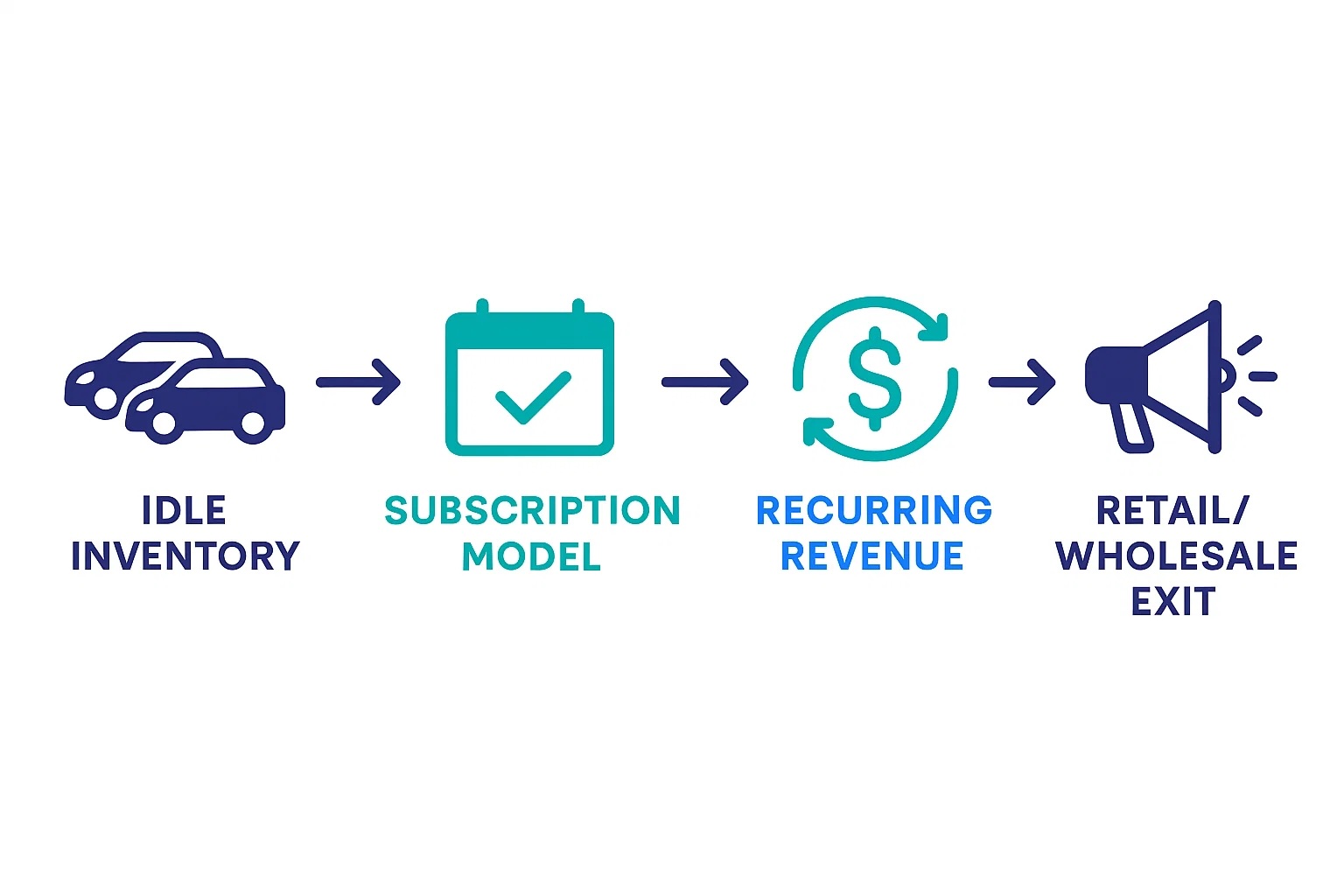What if those slow-moving vehicles on your lot could become the key to unlocking new revenue streams and attracting more customers?
TL;DR / Key Takeaways
- Transform aged inventory into an opportunity by leveraging subscription models.
- Subscriptions unlock new revenue streams while keeping your fleet active and productive.
- Cater to changing customer preferences with flexible, digital-first experiences.
- Drive higher vehicle utilisation rates and reduce operational friction with scalable solutions.
- Stay competitive by modernising access models and adapting to evolving market demands.
Every dealer knows the feeling. You walk onto the lot and see that same saloon that's been sitting there for 75 days, accumulating dust and eating into your margins at $30 to $40 per day in holding costs. Finance charges, depreciation, insurance, and valuable lot space all add up whilst that vehicle transforms from an asset into a liability.
But what if those aged vehicles could become your most profitable inventory instead? Car subscription software is revolutionising how US auto dealers approach their slowest-moving stock, turning what was once a drain on resources into predictable recurring revenue streams. The opportunity is substantial, particularly for dealers willing to embrace this shift before their competitors catch on.
The timing couldn't be better. With 70% of consumers now prioritising flexibility in their mobility choices and used car subscription markets projected to reach significant growth, forward-thinking dealers are discovering that subscription isn't just another revenue channel, it's a complete transformation of how inventory performs.
The Hidden Cost of Vehicles That Don't Sell
Used vehicles sitting beyond 60 to 90 days represent more than inconvenience, they're profit killers. Industry data shows that margins fall by 45% to 60% once vehicles exceed 30 to 45 days on the lot. Each passing day compounds the problem as finance costs accumulate, depreciation accelerates, and opportunity costs mount.
The mathematics are stark. A vehicle that could have generated $15,000 in profit when fresh becomes a break-even proposition after three months. Beyond that point, dealers face the grim choice between wholesale losses or continued hemorrhaging through holding costs. With used car subscription becoming increasingly attractive to consumers, these traditional approaches feel increasingly outdated.
Capital tie-up presents another challenge. Every vehicle represents thousands of pounds locked away that could otherwise fund faster-turning inventory. When dealers have significant portions of their working capital trapped in aging stock, their ability to respond to market opportunities diminishes substantially.
Market pressures compound these challenges. Used vehicle margins continue compressing year over year according to NADA data, whilst consumer expectations shift toward digital-first, flexible ownership models. By 2025, analysts project that 25% of global passenger car sales will occur online, suggesting that traditional lot-based sales models face fundamental disruption.
Understanding Car Subscription: Beyond Traditional Models
Car subscription represents a fundamental departure from conventional vehicle access models. Unlike leasing, which locks customers into rigid long-term commitments, or daily rental designed for short-term needs, subscription offers monthly access with bundled services including insurance, maintenance, and roadside assistance.
The key differentiator lies in customer-centricity. Modern consumers increasingly expect "as-a-service" experiences across all sectors, from software to entertainment. Vehicle subscription aligns with these expectations by removing the friction points that complicate traditional car ownership: insurance paperwork, maintenance scheduling, breakdown concerns.
Digital-first onboarding streamlines the entire customer journey. Rather than lengthy dealer visits involving credit checks, insurance arrangements, and paperwork, customers can begin their subscription journey online, complete verification remotely, and receive their vehicle with minimal administrative burden.
This model particularly appeals to demographics that traditional dealerships sometimes struggle to engage: younger professionals prioritising convenience over ownership, urban dwellers avoiding parking and maintenance hassles, and anyone seeking flexibility in their mobility choices.
The Compelling Business Case for Dealers
- Recurring Revenue Transformation: Subscriptions revolutionise vehicle inventory economics by creating predictable, compounding monthly income. A vehicle generating $15,000 in a traditional sale could yield $7,200 annually through subscription, all whilst preserving its residual value.
- Optimal Inventory Utilisation: Effectively move ageing inventory, transforming vehicles that might otherwise incur wholesale losses into performing assets within subscription fleets. Dealers maintain control over eventual remarketing.
- Deepened Customer Relationships: Ongoing engagement fosters stronger customer connections. Subscribers interact monthly through payments and service touchpoints, frequently converting into future retail sales or recommending the dealership to others.
- Significant Competitive Advantage: Differentiate from traditional competitors and online disruptors. With the global car subscription market projected to reach $33 billion by 2030, according to BCG research, early movers are strategically positioned to capture substantial market share.
- Effective Risk Management: Implement pilot programmes, starting with small fleets of 10 to 30 vehicles, to test demand and refine operations. This approach allows for valuable learning and adaptation without requiring major upfront investment.
Why US Dealers Hold Unique Advantages
American dealers possess assets that position them perfectly for subscription success. Existing vehicle inventory provides instant fleet capability without additional acquisition costs. Established service infrastructure enables the bundled maintenance that differentiates subscription from basic rental models.
The competitive landscape remains relatively open compared to mature markets. Whilst various players have entered the space, no dominant platform has emerged, creating opportunities for dealers to establish market presence before competition intensifies.
First-mover advantages compound over time. Early subscription adopters build customer databases, refine operational processes, and establish brand recognition whilst competitors remain focused on traditional models. These advantages become increasingly difficult to replicate as markets mature.
Local market knowledge provides additional differentiation. Dealers understand their customer bases, seasonal patterns, and regional preferences in ways that national or international subscription services cannot match. This insight enables more targeted offerings and superior customer experiences.
Addressing Common Dealer Concerns: FAQs
Q: Isn't this just leasing?
A: Not quite. Subscriptions differ from traditional leasing by offering shorter terms, greater flexibility, and all-inclusive service bundles. Unlike leasing, subscriptions allow customers to pause, upgrade, or end their plans with minimal penalties.
Q: What about residual value risk?
A: Residual value concerns are valid but manageable. Subscription vehicles are returned sooner than leased ones, giving dealers better control over remarketing. Additionally, well-maintained subscription fleets often have premium residual values due to documented service histories.
Q: How do we handle insurance and maintenance?
A: Insurance and maintenance can be simplified through platform partnerships. Leading subscription software providers handle these details, bundling coverage and coordinating service delivery.
Q: What technology investment is required?
A: A digital platform is essential for customer onboarding, payment processing, and fleet management. Modern solutions integrate seamlessly with dealer systems, minimising disruption and maximising efficiency.

Download Our Free White Paper: How US Dealers Are Turning Aged Stock Into Recurring Revenue
Launching Your Subscription Pilot
To launch a successful pilot programme, dealers should focus on several key areas. These strategic considerations will help you validate demand, refine processes, and pave the way for a scalable subscription service.
- Assess Your Inventory: Begin by identifying vehicles in your aging inventory that have exceeded their typical turn time but remain appealing to subscription customers.
- Identify Your Target Customer: Pinpoint demographics that value flexibility over traditional ownership.
- Determine Your Fleet Size: Start with a modest fleet of 10 to 30 vehicles.
- Leverage Technology Partnerships: Partner with an established car subscription software provider for seamless operations.
- Define Key Metrics for Success: Track metrics like monthly recurring revenue, vehicle utilisation, and customer churn to fine-tune your programme.
The Time for Action is Now
Market conditions align perfectly for subscription adoption. Consumer demand for flexibility continues growing whilst the competitive landscape remains accessible. Dealers who establish subscription capabilities now will capture first-mover advantages before market saturation occurs.
Subscription doesn't replace traditional sales, it enhances dealer capabilities with an additional profitable channel. The goal isn't transformation of entire operations but expansion of revenue opportunities through improved inventory utilisation.
Delaying risks ceding ground to more agile competitors or direct-to-consumer OEM models. As subscription becomes mainstream, dealers without these capabilities may find themselves disadvantaged in increasingly competitive markets.
The infrastructure for success exists today. Car subscription software platforms like tomorrow's journey provide the technology backbone whilst dealer expertise in customer service and vehicle management creates competitive differentiation.
Transform Your Inventory from Cost Centre to Profit Engine
Subscription transforms the fundamental relationship between dealers and aging inventory. Rather than watching valuable assets depreciate on lots, forward-thinking dealers are converting slow-moving stock into recurring revenue streams whilst preserving long-term relationships with customers.
The opportunity extends beyond immediate financial benefits. Subscription positions dealers at the forefront of mobility transformation, building capabilities that will prove increasingly valuable as consumer preferences continue evolving. Early movers will establish market presence, customer relationships, and operational expertise that competitors will struggle to replicate.
Market timing rarely aligns as perfectly as it does today. Consumer demand continues growing, competitive landscapes remain accessible, and technology solutions have matured sufficiently to support successful implementations. The question isn't whether subscription will transform automotive retail, but whether you'll lead or follow this transformation.
Want To Learn More. Get Our Free White paper
Want to see how U.S. dealers are already turning aged inventory into recurring revenue? Our white paper, The Subscription Advantage, breaks down why subscription works, the benefits you can expect, and how to start small with a pilot. It’s a practical, no-nonsense guide designed for dealer leadership teams who want to explore new profit channels without overhauling their operations.
Download the free white paper.
Explore Our Latest Insights
Discover trends and innovations in the automotive sector.





